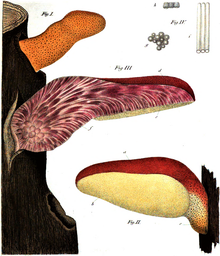|
Fistulina hepatica
Fistulina hepatica, commonly known as the beefsteak fungus, beefsteak polypore, poor man’s steak, ox tongue, or tongue mushroom, is an unusual bracket fungus classified in the Agaricales. It can be found in Europe, Africa, Australia, and North America. As its name suggests, it looks much like a slab of raw meat. It has been used as a meat substitute in the past, and can still be found in some French markets. It has a sour, slightly acidic taste. For eating, it must be collected young and it may be tough and need to be cooked for a long time. DescriptionThe cap is 7–30 centimetres (3–12 in) wide and 2–6 cm (3⁄4–2+1⁄4 in) thick.[1] Its shape resembles a large tongue and it is rough-surfaced. It is pinkish-red when young, darkening to reddish-brown with age. The spores are pink[1] and released from minute pores on the creamy-white underside of the fruit body. It bleeds a dull red juice when cut, which can cause stains,[1] and the cut flesh further resembles meat.[2] It is sour in taste.[1] The underside of the fruiting body, from which the spores are ejected, is a mass of tubules. TaxonomyFistulina is classified in the family Fistulinaceae;[3] molecular studies suggest close relations to the agaric mushroom Schizophyllum in the Schizophyllaceae (in the schizophylloid clade), but in the separate sister fistulinoid clade.[4] Fistulina is a cyphelloid genus, meaning that it is closely related to gilled fungi, but its fertile surface consists of smooth cup-shaped elements instead of gills. The underside (the hymenium) is a mass of tubules which represent a "reduced" form of the ancestral gills. EtymologyThe genus name is a diminutive of the Latin word fistula and means "small tube", whilst the species name hepatica means "liver-like", referring to the consistency of the flesh. Distribution and habitatThe species is commonly seen in Britain and the rest of Europe from July to October,[5] but can also be found in North America, Australia, North Africa, and Southern Africa. It is fairly common, and can often be found on oaks and sweet chestnut, from August to the end of autumn, on either living or dead wood. It has a tendency to impart a reddish-brown stain to the living wood of oaks, creating a desirable timber type. In Australia, it can be found growing from wounds on Eucalyptus trees. It causes a brown rot on the trees which it infects.[6] UsesIt is edible and considered choice by some,[7] although older specimens should be soaked overnight, as their juice can cause gastric upset.[8] It does not tend to preserve well.[5] See alsoReferences
External links
Wikimedia Commons has media related to Fistulina hepatica. |
||||||||||||||||||||||||||||||||||||||||||||||||||||

